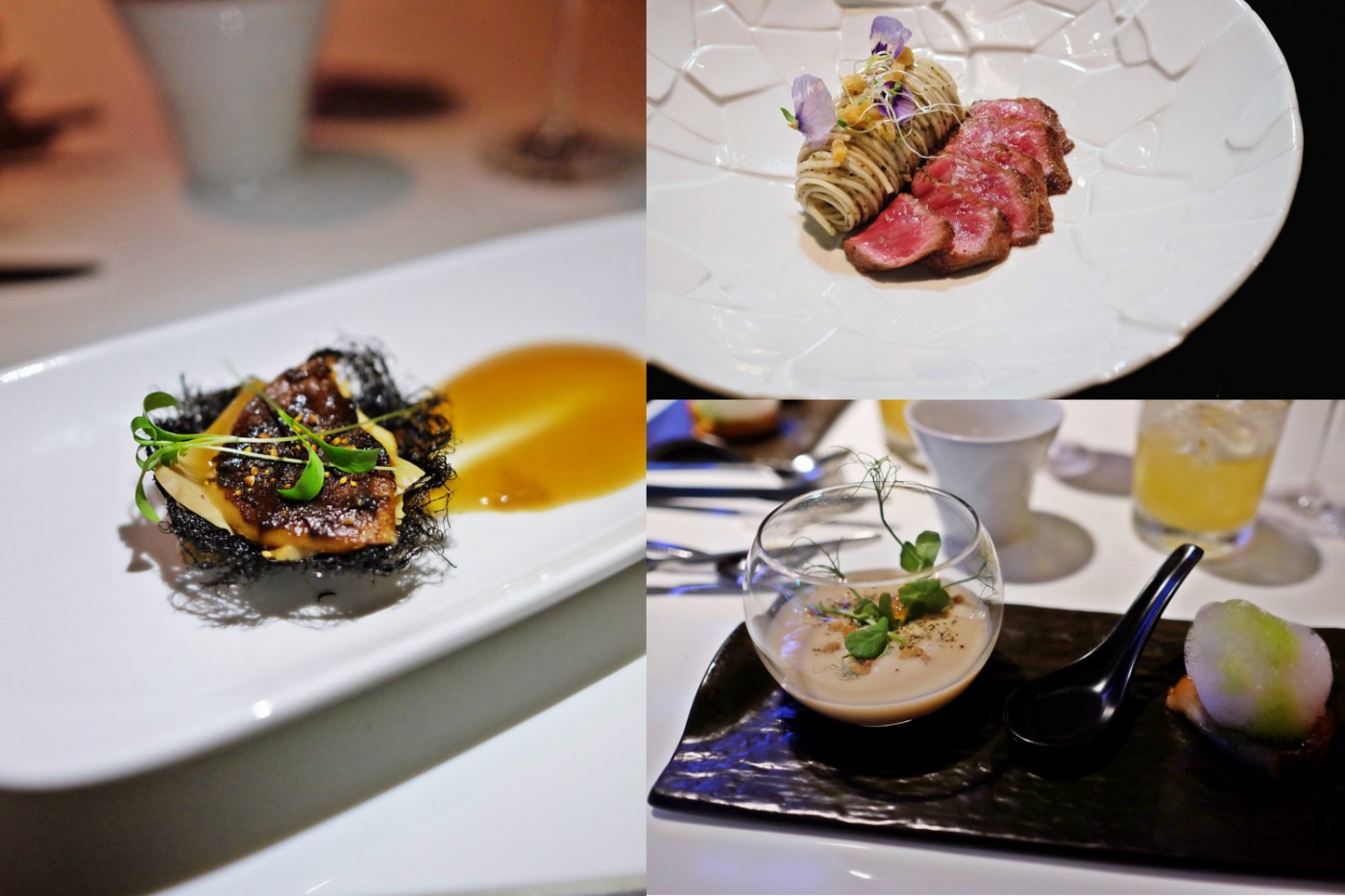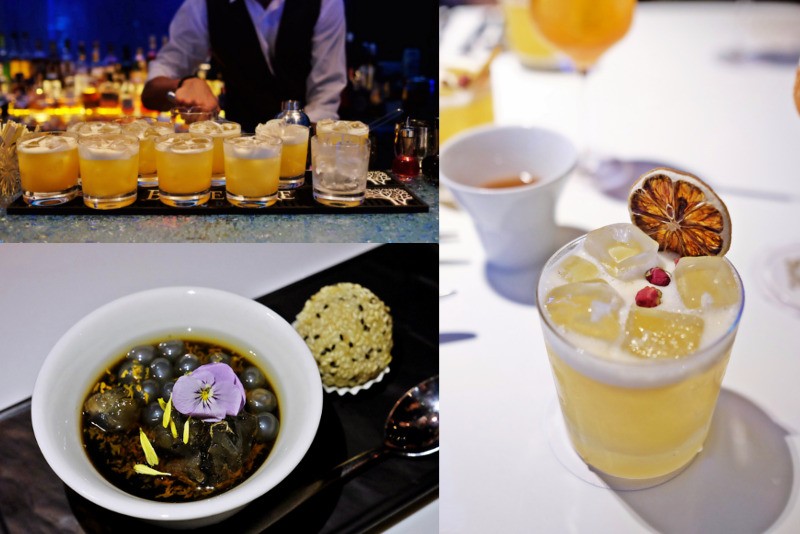Labyrinth X Mitzo: Modern Singaporean Cuisine Meets Tough Cantonese Cookie
We’ve had our fair share of collaboration dinners this year. From Michelin starred mega-powerhouse mash-ups to hawker-entreprenuers and edgy kiosk owners putting their heads together in a bid to produce addictive street food options. It’s not uncommon to have at least 5 such events on the weekly update. However, when recently minted 1 Michelin-starred Han Li Guang of Labyrinth steps into the light of the strict Cantonese regimentation of Mitzo’s Chef Nicky Ng’s kitchen, instantly our ears perk up in anticipation of culinary roofs being demolished.
Sure enough, the meal comes to a rousing start with the dim sum platter highlighting each of the chef’s prowess. The Sea Urchin Custard Bun breeds a certain sort of familiarity on its forefront, the tell-tale sign of a shard of uni nestled on the top giving clues of the ‘elevated cuisine’ that is about to unfold. The Truffles Shrimp Dumpling with resplendent pleating and flecked with a pretty purple hue explodes on the palette with strong ferocity.
The Fish Maw Soup with seasonal green in pork consommé follow suite. It’s warm, enthralling and speaks to the soul. Smack your lips together after slurping on your last spoonful and you’ll be faced with a sticky situation from the collagen overload.
Diners were stoked for the next two courses on the menu. One word: Abalone. Another word: Congee. Yes, despite the disparity in perceptions tied to both these dishes, both delivered immense gourmet returns. In the former, Chef Han manufactures his own oyster sauce to top the excellently cooked abalone slices, offering a slew of umamified flavours from the get-go. The latter involves a tedious workflow and it pays off in the form of triple sieved congee to derive a sticky amalgamation of seafood stock fuelled starch mix, graced with the presence of a sous vide egg yolk to mimic the traditional dish. Culinary boundaries are crossed when Chef Nicky compliments that humbly disguised ingenuity with a side of perfectly cooked sea bass topped with ginger espuma. Spoons and chopsticks will cross track as the methods of approaching the tantalising dish in terms of merging flavours, challenges preconceived notions of traditional versus modern preparation.
The chefs round off the meal with a flurry of textures and varied temperatures for an ultimate sensory experience. Chilled Herbal resin jelly supplies the subdued bitter notes whilst the Deep Fried Hokkaido Milk Cheese Dumpling panders to the sweet tooths.
Chef Han Li Guang believes that collaboration dinners are quintessential to bringing two chefs with the same synergy and passion together. The end result: mutual respect and inspiration on a plate. When asked “Who is your dream chef to collaborate with?” he met my glance with a quizzical smile, impudent and almost provocative.
HNW: How was your collaboration experience with Chef Nicky Ng? Did you acquire new skills while working with this Cantonese Chef?
HAN LI GUANG: It was a very enriching experience for me. In fact, the best part of today was the opportunity to watch them at work. I’ve been mostly fascinated by wok work since I’m honestly not very skilled at it. Fun fact, I did a day’s worth of work experience at Keng Eng Kee for fun. It was back-breaking menial labour, and needless to say, after a day, I didn’t go back.
Watching a team of Cantonese chefs working and cooking together is almost like poetry. The speed at which they function with a wok is truly amazing.
One of the things I’ve learnt at Mitzo is their methodology of making that wicked char siew. At Mitzo, they are famed for those lardaceous slices. I asked Chef Nicky, ‘What sorcery is this?’ and he decided to let me in on his secret. Most people would roast it for the first time with the marinade, leave it and then slice it. Chef Nicky, on the other hand, roasts it, covers it in the same sauce for the second time, albeit intensified with a higher sugar content and then torches it. Essentially, it’s like a brûlée. I find it thoroughly interesting that someone so traditional would push his own dish by thinking out of the box. It’s inspiring to see how an additional step could elevate the final product.
Is there a dream chef you would like to do a collaboration with?
I have no idea. Anyone who is good at his craft and interesting would suffice. What’s more important is that we have the same synergy and passion. Right off the top of my head, I would love a shot at cooking alongside Jordy Navarra, chef-owner of Toyo who has experience at The Fat Duck and Bo Innovation. He prides himself in doing mostly molecular gastronomy and his kitchen is armed with a bevy of old school equipment from firestones to wok stoves, French top stoves and even a brick oven. Despite my graduation from pure molecular gastronomy, I would love to work with all these traditional equipment he owns. He does a lot of things from scratch, this includes making his own fish sauce, fermenting his own squid, down to making his own koji in the restaurant. I’ve learnt that he sources his own glutinous flour and makes his own dough from it. Imagine the endless possibilities of that derivation!
I have many chefs out there that I idolise, one of them being Dan Barber, chef and co-owner of Blue Hill in Manhattan and Blue Hill at Stone Barns in New York. After reading his book, I have a deep respect for his commitment for natural flavours. It’s amazing how he goes to such lengths to coax that out of his ingredients—especially with globalisation instigating restaurants to use store-bought sauces.
Do you face the same challenges at Labyrinth?
My main struggle is finding natural produce to work with. We’re talking about produce that speaks for itself. Given that local farming is in its infant stages, people don’t question deeper as to what benefits or effects the tolls of being grown and farmed locally have on the produce. I take it upon myself to understand the unique qualities bourne of this origins, intensify those qualities and pay homage to it through preparation methods. Right now, the focus is on natural flavours; the restaurant is starting on flour now and eventually, we’ll boil down to meats and roots. Labyrinth’s culinary direction hasn’t quite been truly defined yet, hence we hope to see a lot more evolution in the next few years. At the end of the day, the main aim is to elevate Singaporean cuisine.
What is the one Singaporean dish that you find the most challenging to recreate?
It’s hard to say. Chicken rice was a huge challenge for us—we went through two renditions of it already. It’s hard to redefine the traditional sentiments tied to a dish that’s so deeply rooted in the hearts of the locals.
I would have to say fried rice, too. It tastes good but there’s nothing there. If we were to reconstruct it in a different form, as a porridge or risotto, then it would lose its essence. Perhaps I would make my own natural MSG using onions, mushrooms and seafood. Rice is a given, and that makes it a real challenge to recreate.
How have things changed for Labyrinth after receiving a 1-star?
We’ve been full every day. Some people would say that I’m a brat for always complaining about brisk business. However, I’ve only got 3 full-time chefs in the kitchen and myself. Since I’m mostly occupied running events and marketing, everyone in the kitchen is suffering. The good thing would be the change in the demographics of our clients. When we first started, a majority of our reservations were from the locals, but that has changed significantly since the award and we’ve been attracting more tourists who are now aware of our efforts to modernise Singaporean cuisine.
What’s the next step for Labyrinth?
Our next step would be to move away from recreating dishes. Instead, we would like to retain that as a mere element of inspiration. I’m highly inspirited by congee and black chicken these days; recently I made a century egg sauce and porridge which leans towards the sticker spectrum—using new rice, old rice and touch of glutinous rice, I’ve laid hands on this old school recipe that my mentor handed down to me, which yields a highly desirable texture.
Flavours aside, I would love to move to a new location. The National Gallery would be my first pick since our synergies are on par, given that we both focus on tradition. Right now, we are trying to go upmarket, not spurred on by the fact that we want to charge our customers more, but because I’m beginning to see Labyrinth’s culinary direction more clearly now. The time has come to move towards being coined as innovative in an elegant modern way and not be entirely stiff, which is how fine dining is normally portrayed to be.
The Labyrinth X Mitzo collaboration was part of the 3-part series of collaborative dinners, ‘Friends of Mitzo’. To witness Chef Nicky in a cross culinary crusade with more of Singapore’s finest modern cuisine innovators, stay tuned to their page for updates.
The next Friends of Mitzo: Morsels X Mitzo, a collaboration between Chef Nicky Ng and Chef Petrina Loh will be happening from 8 – 10 September 2017 (Fri – Sun).




